El sutil arte del seguimiento con la automatización del correo electrónico
Cómo masajear a sus clientes potenciales para que le importen una mierda, automáticamente.
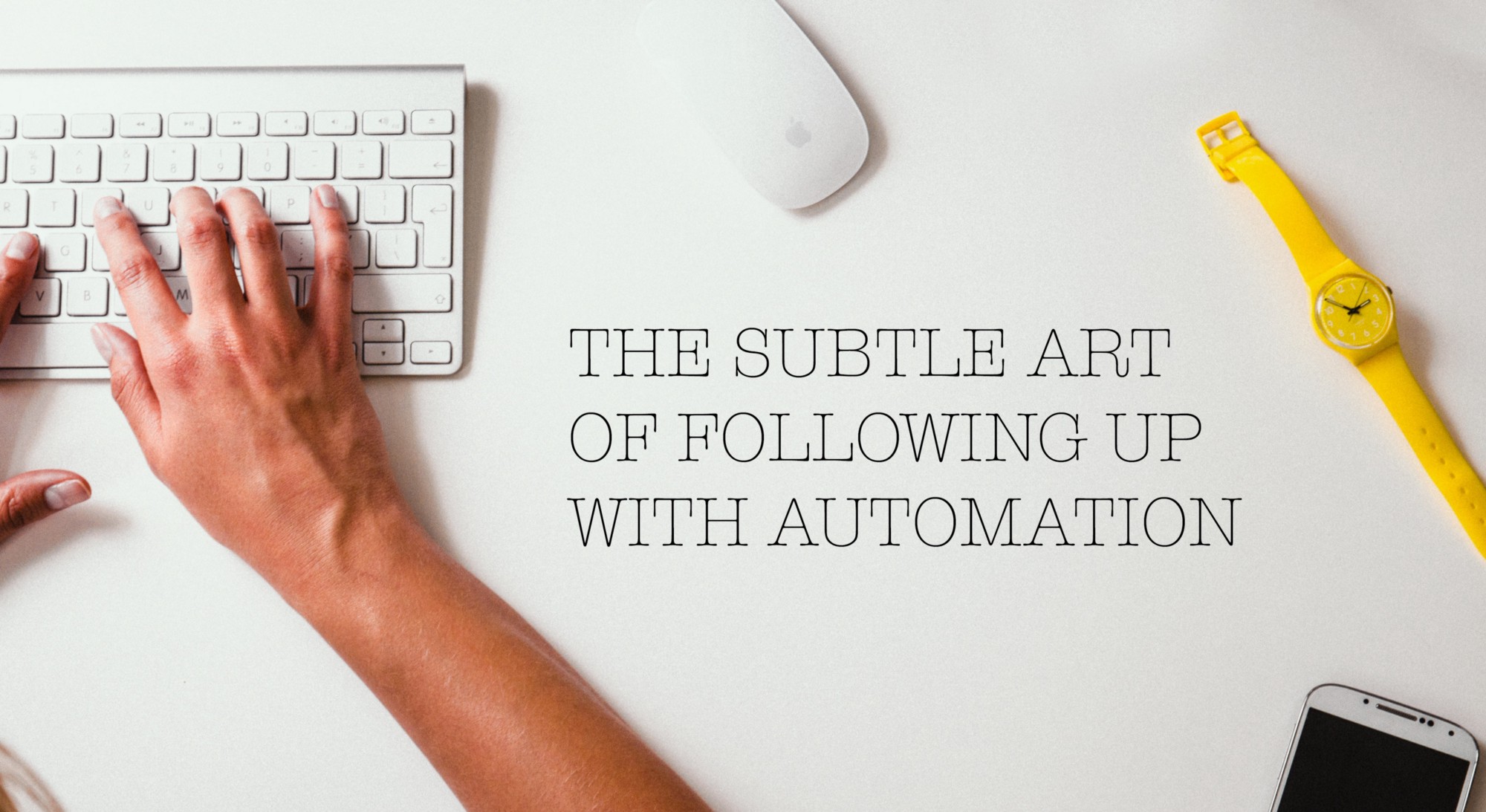
Así que...
Has encontrado jugosos clientes potenciales utilizando tácticas inteligentes de redes sociales y trucos de crecimiento.
Te pusiste en contacto con nosotros con un impresionante correo electrónico en frío que casi parece escrito a mano, pero que en realidad se envió en lotes automatizados mientras estabas profundamente dormido, utilizando datos y una herramienta de automatización de correo electrónico en frío.
Has dado en el clavo con uno de tus clientes potenciales y te envía un correo electrónico.
Desecha eso.
Como ha estado enviando miles de esos correos electrónicos, cientos de sus clientes potenciales le están respondiendo con correos electrónicos.
¿Y ahora qué, genio?
Si tiene una tasa de respuesta de aproximadamente 3% y utiliza la automatización del correo electrónico para ampliar su alcance de 10 a 300 correos electrónicos al día, tendrá 270 nuevos clientes potenciales a los que hacer un seguimiento cada mes.
Todos y cada uno de ellos requieren tu valor, cuidado, paciencia y disponibilidad para convertirse en un trato. De hecho, las estadísticas muestran que 80% de las ventas requieren al menos cinco seguimientos, lo que significa que vas a tener que enviar más de mil correos electrónicos para dar a todos esos clientes potenciales la atención que merecen.
En resumen: si no estás preparado para la tarea, la automatización te enterrará en el suelo en lugar de dispararte a las estrellas.
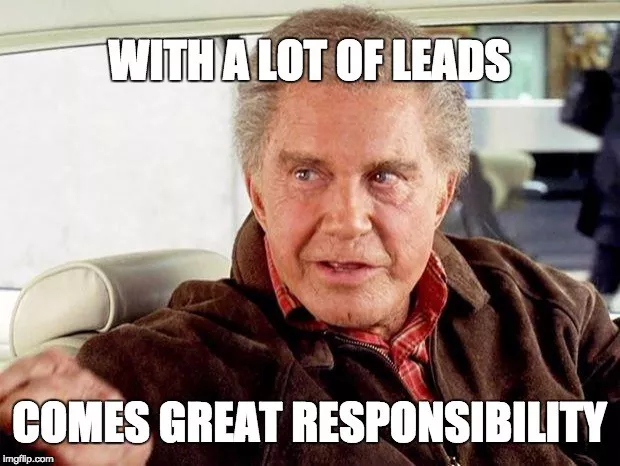
Este artículo no trata de la importancia del seguimiento ni de cómo hacerlo. Se trata de cómo ser inteligente al respecto, cómo construir una cantidad máxima de relaciones humanas fructíferas sin ahogarse en su propia tubería, cómo hacer más con menos.

Empecemos por el "por qué
¿Por qué molestarse en hacer un seguimiento?
Porque funciona. El seguimiento consigue ventas.
Las estadísticas muestran que 80% de las ventas se realizan después de al menos cinco seguimientos.
Las estadísticas también muestran que el 44% de los representantes de ventas abandonan tras el primer rechazo.
Se pone mejor:
- 22% suspende el seguimiento tras dos rechazos
- 14% dejar de seguir después de tres
- 12% dejar de seguir después de cuatro
👉🏼 92% de los representantes de ventas abandonan antes del crucial quinto seguimiento.
Has leído bien: puedes vencer a 92% de los representantes de ventas con sólo ser persistente.
Sin embargo, es más fácil decirlo que hacerlo. La mayoría de los representantes de ventas saben que deben hacer un seguimiento constante, pero tienen miedo de hacerlo. Temen ser rechazados.
Enviar innumerables correos electrónicos a alguien para luego ser ignorado o rechazado una y otra vez te hace sentir que eres molesto y nadie quiere ser molesto.
Pero, ¿qué puedes perder?
El primer contacto es fácil. Has superado el obstáculo de acercarte a alguien. Has concertado esa reunión, has hecho esa llamada telefónica, has enviado ese correo electrónico. Has hecho tu trabajo, te sientes bien contigo mismo. Ahora depende de ellos, ¿no?
Ahí es donde te equivocas.
Métetelo en la cabeza: que recibas una respuesta de tu cliente potencial depende de ti. No tienes derecho a nada y esperar no te llevará a ninguna parte.
¿Por qué hacer un seguimiento? Porque es bueno para el negocio.
Necesita una herramienta CRM
Antes de transformarte en un superhéroe del seguimiento por correo electrónico, tenemos que ponerte al volante.
Recuerde, estamos asumiendo que ha utilizado la automatización para el alcance personalizado a escala. Ningún truco de magia servirá de mucho si no estás preparado para gestionar las oleadas de respuestas que provocan tus campañas automatizadas.
Aquí es donde entramos en el terreno del software CRM. Una herramienta que te permite entablar relaciones humanas con multitud de clientes potenciales a la vez.
En Salesflare creemos que la mayoría de las herramientas de CRM consiguen lo contrario: le obligan a registrar llamadas, actualizar contactos, adjuntar correos electrónicos y otras tareas administrativas sin sentido que los humanos no deberían hacer. Te mantienen alejado de lo que realmente importa: hablar con los clientes potenciales.
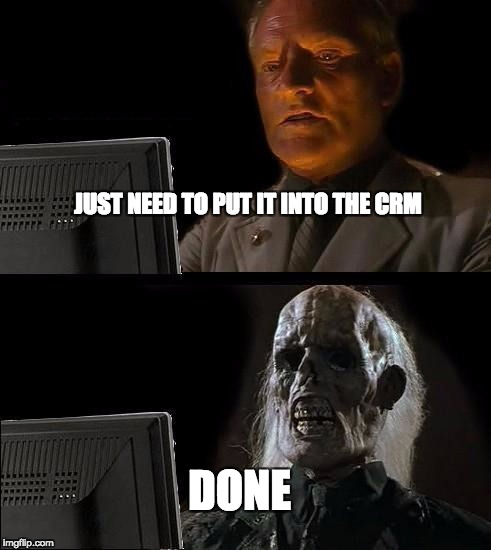
Hemos creado Salesflare como una herramienta que le ayuda sin que usted tenga que ayudarle primero. Algo que es más un asistente de ventas que una hoja de cálculo.
En adelante utilizaremos Salesflare como CRM de referencia en la ecuación de seguimiento, sin que la táctica sea exclusiva de él.
Automatice todo lo que no le necesite
Para concentrar todo tu tiempo y talento en el seguimiento y la creación de relaciones, primero tienes que deshacerte de todo lo demás que te lo impide.
La tecnología ha madurado hasta el punto de que ya no necesita la supervisión de un adulto. Aprovéchate de ello. Haz que los robots se ocupen del trabajo de los robots para que tú puedas centrarte en las cosas que importan.
Puede automatizar prácticamente todo directamente hasta el punto en que se le necesite en la conversación. No es necesario programar, basta con combinar Salesflare y Zapier.
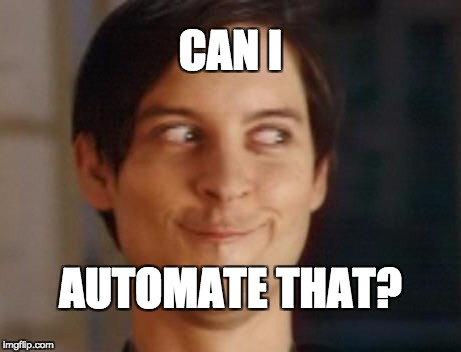
Zapier permite conectar apps SaaS entre sí y hacer que funcionen juntas en flujos autónomos. La idea es bastante sencilla: cada app tiene una serie de disparadores y una serie de acciones. Sólo tienes que indicar qué disparador de una app quieres que desencadene qué acción en la otra.
Una acción desencadenada se denomina Zap. Dependiendo de lo complejo que sea el flujo, necesitarás uno o más Zaps para que funcione.

El ejemplo más relevante en este caso sería enviar automáticamente los clientes potenciales de su programador de reuniones a su CRM.
Eso se vería así:
- Usted envía correos electrónicos personalizados a escala utilizando los flujos de trabajo de correo electrónico en Salesflare. (¿Quiere ver cómo? Aquí hay un cliente que muestra cómo utiliza los flujos de trabajo de correo electrónico para la prospección).
- En tu correo electrónico, sugiéreles que reserven una reunión contigo a través del enlace personal de tu programador de reuniones (como YouCanBook.me o Calendly).
- Configuras Zapier para crear automáticamente una cuenta/empresa, un contacto y una oportunidad en tu CRM, Salesflare. Incluso puedes crear automáticamente una tarea de seguimiento y almacenar algo más de información en campos personalizados o en una nota interna. Sólo tiene que utilizar su imaginación. 🤯
Ahora todo lo que tiene que hacer es lanzar una campaña saliente y su canal de ventas se llenará automáticamente de clientes potenciales, listos para que les haga un seguimiento.
Por supuesto, tus leads no tienen por qué proceder del correo electrónico. También puede utilizar Zapier para enviar clientes potenciales a su CRM desde formularios (por ejemplo, Typeform, Google Forms), Facebook Lead Ads o chatbots (Collect.chat, ManyChat, Chatfuel). Eche un vistazo a nuestras plantillas Zapier para inspirarse.
Cómo ganar en el seguimiento
A partir de ahora todo es cosa tuya.
Ya lo hemos mencionado antes: el único superpoder que necesitas es la constancia. La carrera se gana corriendo, no siendo rápido.
¿Cómo ganar en el seguimiento? Sigue haciéndolo hasta que obtengas una respuesta, sea cual sea. Recibir un "no" no es perder. Te permite pasar a la siguiente e invertir tu tiempo y talento donde importa.
Esa es la mentalidad que necesitas para entrar en el juego. Ahora añade los siguientes 11 ingredientes a la fórmula para convertirte en un campeón del juego.
1. La ejecución es algo, el tiempo lo es todo
Con "respuesta" me refiero realmente a respuesta. No recibir un correo electrónico de vuelta no cuenta y no debería detenerte.
Con demasiada frecuencia, los vendedores asumen que el silencio es una señal de rechazo, cuando en realidad se trata simplemente de un mal momento.
En primer lugar, su correo electrónico podría haberse perdido en el desorden y la confusión. Utilizar el seguimiento del correo electrónico puede arrojar algo de luz aquí. Si utiliza la barra lateral de correo electrónico de Salesflare para Gmail o Outlook o el correo electrónico desde el propio CRM, puede decirle si un correo electrónico se ha abierto o no.
Incluso si el destinatario ha abierto el correo electrónico, existen muchas razones posibles, aparte del rechazo, para que los clientes potenciales no respondan al mensaje:
- no están disponibles (enfermedad, viajes, problemas personales)
- están en medio de otra cosa
- simplemente se olvidaron de contestar
Sea lo que sea, no te lo tomes como algo personal. Asumir que no te han contestado a un correo porque te han rechazado es una mentalidad perdedora. Cambia las cosas: asume que el momento no era el adecuado e inténtalo de nuevo.
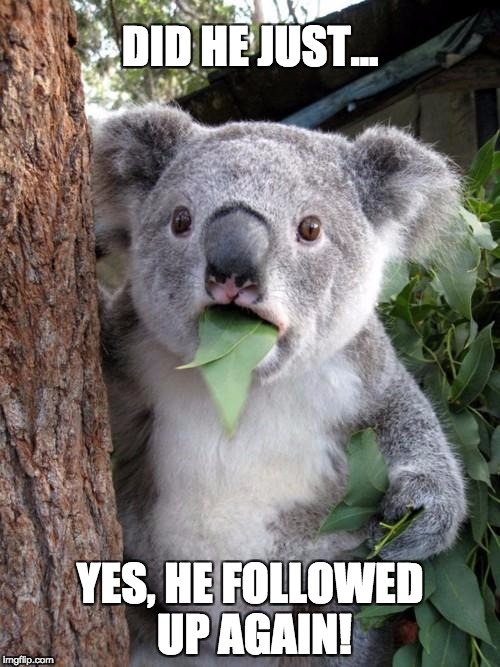
Puede que te hayan ignorado porque no les interesas, o puede que no.
Lo único que sabes con seguridad es que no lo sabes. Sal de la tierra de los "quizás" y haz un seguimiento hasta que lo sepas. Los únicos resultados con los que debes conformarte son el "sí" y el "no".
En el juego del seguimiento, recibir un "no" no es perder, es ganar. Cuando alguien te dice que no está interesado, puedes moverte y centrar tus esfuerzos en el siguiente posible cliente. La única forma de perder en el seguimiento es quedarse en el "tal vez".
2. Perseguir la claridad antes que caer bien
¿Por qué es tan difícil mirar más allá del silencio y seguir investigando hasta dar con alguien?
Tienes miedo de molestar.
Pues adivina qué: ya no estás en el instituto. Ser popular no va a hacer crecer tu negocio. Las ventas sí.

Dicho de otro modo: aspire a no gustar a siete personas y a que tres hagan negocios con usted en lugar de gustar a diez personas y que cero hagan negocios con usted.
Los siete a los que rechazas porque intentas aportarles valor no merecen tu energía de todos modos. Invierte esa energía en las personas que sí importan.
3. Saber cuándo parar
Algunas personas utilizan el silencio para decirte que no están interesadas.
Como regla general, cinco contactos sin respuesta equivalen a un "no". Puedes dar por sentado que no les interesa lo que ofreces e invertir tu energía en otra persona.

Otra gran idea puede ser dar un paso atrás a la hora de vender y preguntarles primero su opinión sobre algo. Podría tratarse simplemente de una pregunta personal, o podría ser algo más formal y automatizado utilizando una plataforma especializada en opiniones de usuarios, como Mopinion, donde puedes recopilar opiniones por correo electrónico.
4. Estar presente sin ser tacaño
¿Con qué periodicidad hay que hacer un seguimiento después de enviar el primer correo electrónico?
Empiece con fuerza y disminuya la frecuencia con el tiempo. Cuanto más tiempo pase sin que un cliente potencial responda, más probable será que el intervalo de tiempo no sea el adecuado.
He aquí un esquema general para empezar:
- Día 1: Primer correo electrónico de seguimiento
- Día 3: 2º seguimiento
- Día 7: Seguimiento 3d
- Día 14: 4º seguimiento
- Día 25: 5º seguimiento
- Después: una vez al mes
Si ha establecido una conexión con su cliente potencial sin que esté inmediatamente interesado en su producto, sigue teniendo sentido hacer un seguimiento con él una vez al mes, simplemente para mantener la relación. Juegue a largo plazo. Su red es su valor neto, nunca se sabe qué beneficios puede reportar una conexión.
Para la captación en frío, puede automatizarla fácilmente utilizando secuencias en su herramienta de automatización del correo electrónico.
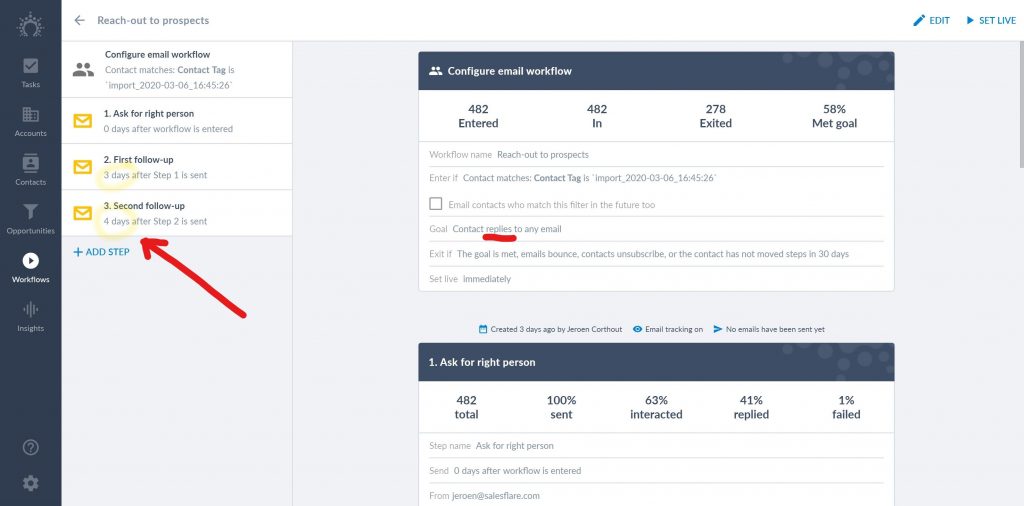
Puede reproducir perfectamente su rutina de seguimiento en un flujo de trabajo de correo electrónico Salesflare e incluso añadirle cierta flexibilidad. Supongamos que en el correo electrónico hay un enlace a su calendario para que los clientes potenciales reserven una llamada con usted: puede hacer que la secuencia se interrumpa también cuando hagan clic en ese enlace.
5. Utilizar recordatorios de seguimiento
El seguimiento no sólo es necesario cuando se realizan contactos en frío. Puede que ya hayas hecho algunos progresos con un cliente potencial, pero las líneas vuelven a enfriarse antes de que te des cuenta. Tu trabajo es mantener viva la relación. Recuerda: no tienes derecho a nada.
"No tengo que escribirlo, lo recordaré".
- No, no lo harás.
Tu cerebro no es una caja fuerte en la que almacenar datos, para eso está la tecnología. Es imposible que no cometas errores al tener que hacer un seguimiento de varias oportunidades al mismo tiempo. Te olvidarás de hacer el seguimiento y perderás ventas.
Aquí es donde entra en juego su CRM. Haz que te diga cuándo debes hacer un seguimiento creando tareas sencillas y/o recordatorios para que puedas centrar tu atención en lo que importa: escribir correos electrónicos excelentes para crear relaciones.
Para crear una tarea en Salesflare, utilice el cuadro superior de la pantalla Tareas.
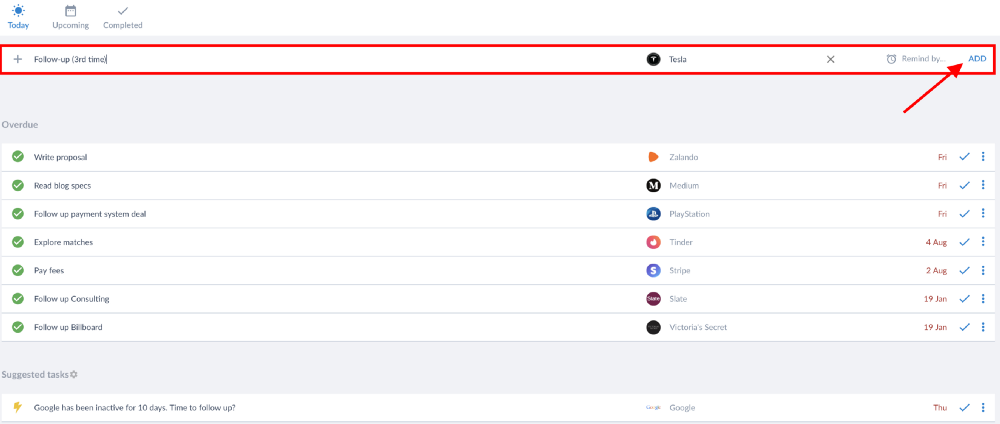
No seríamos Salesflare si no tuviéramos algunos poderes de automatización bajo la manga. Además de las tareas, también nos aseguraremos de que no pierda de vista el balón con recordatorios automáticos de inactividad. Éstos se activarán tras 10 días de inactividad en las oportunidades de tu cartera de ventas.
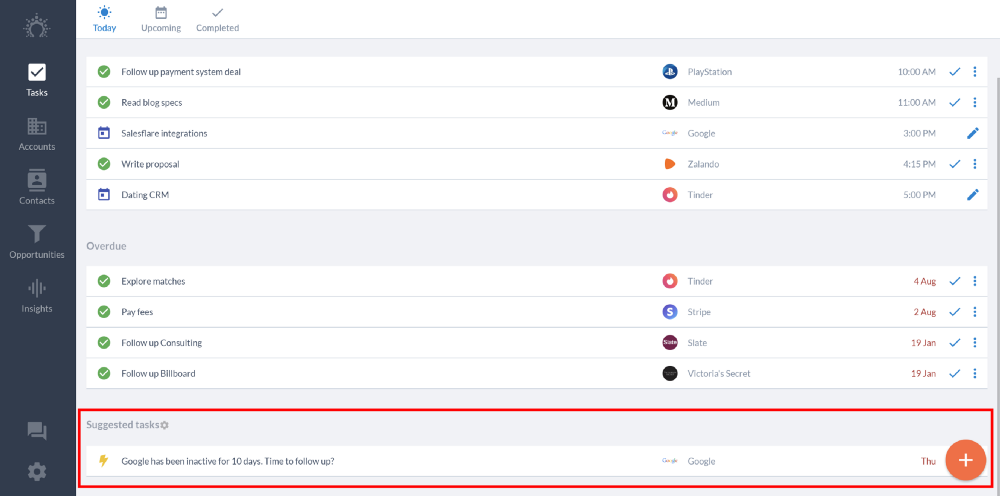
10 días es la configuración estándar, puedes personalizar estos tiempos de acuerdo a las etapas de tu pipeline de ventas. Solo tienes que ir a Configuración > Personalizar pipelines, hacer clic en el lápiz para editar y establecer una cantidad personalizada de días para los recordatorios de inactividad.
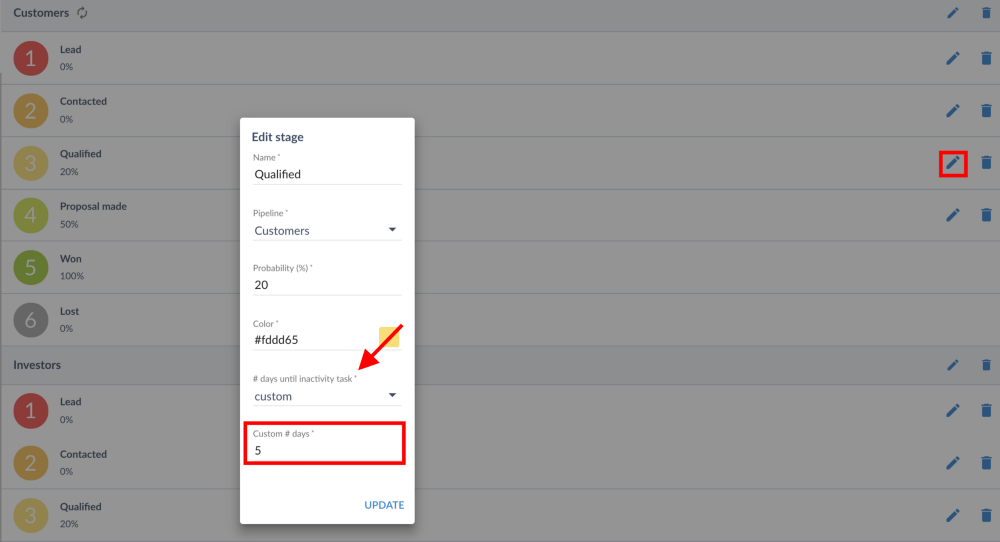
Aún hay más...
En Salesflare, también puede enviar correos electrónicos de seguimiento automáticos en función de desencadenantes como los cambios de etapa.
Ejemplos:
- Un cliente potencial ha respondido a su correo electrónico y ha concertado una llamada con usted. Como este cliente potencial pasa automáticamente del programador de reuniones al canal de ventas de tu CRM, se envía automáticamente un correo electrónico para confirmar la llamada. Hazlo aún más especial enviando un contenido relevante.
- La llamada ha ido bien y el cliente potencial pasa a la siguiente fase del proceso. Esto desencadena un correo electrónico en el que invitas al cliente potencial a tu comunidad de Facebook para que se sienta especial.
- Ha acordado las condiciones con un cliente potencial y, a medida que pasa a la siguiente fase del proceso, se le envía un correo electrónico automático de propuesta.
- Usted vende Saas. El periodo de prueba de un cliente potencial ha caducado, sin que haya realizado ninguna acción para empezar a pagar. Cuando pasa a la fase "Perdido", se le envía un correo electrónico para convencerle de que se suscriba o, al menos, amplíe su periodo de prueba.
6. No siempre tiene que ser por correo electrónico
El seguimiento y el correo electrónico van de la mano, pero hay algo más.
Aunque el correo electrónico sigue siendo la espina dorsal de la comunicación empresarial, otros medios pueden ofrecer más en términos de capacidad de entrega, rapidez de respuesta y efecto general en el cliente potencial.
El juego largo: el correo electrónico
El correo electrónico es la opción más segura y fiable. Le permite insistir varias veces sin ser intrusivo. El cliente potencial tiene el control sobre cuándo y cómo responder, pero también puede tardar mucho en alcanzar sus objetivos.
Para una respuesta más rápida: llamada telefónica
En comparación con el correo electrónico, una llamada telefónica es más difícil de ignorar. Es más probable que la gente coja el teléfono que responda a tu correo electrónico en menos de 2 minutos.
La misma razón hace que las llamadas telefónicas sean más intrusivas que los correos electrónicos. Todos preferimos hacer las cosas en nuestro tiempo libre y las llamadas telefónicas de seguimiento no encajan con eso. El riesgo de convertir un "tal vez" en un "no" es mayor en las llamadas telefónicas que en los correos electrónicos, porque la probabilidad de parecer molesto es mayor.
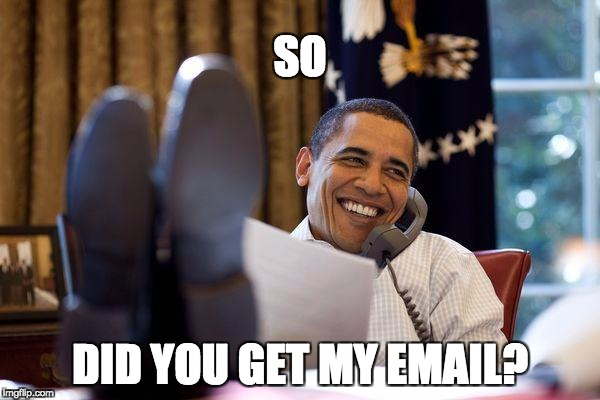
Que seas molesto o no siempre depende de ti. Hay una diferencia entre llamar a alguien una o diez veces al día. Lo primero se llama mostrar interés, lo segundo acosar. Estás avisado.
Puede buscar Sistema de telefonía VoIP para empresas y utilizar un montón de funciones automatizadas, como las respuestas de texto automáticas, para que el proceso de llamadas en frío le lleve menos tiempo. Sin embargo, no disponemos de robots que realicen nuestras llamadas telefónicas (todavía), por lo que, de momento, la mejor táctica es establecer recordatorios estratégicos y utilizar guiones adecuados de llamadas en frío.
El compromiso: SMS
Si tus clientes potenciales tardan demasiado en responder a los correos electrónicos y no cogen el teléfono, puedes probar con los SMS. Como medio de comunicación, no es tan saturado como el correo electrónico y es menos intrusivo que las llamadas telefónicas, lo que lo hace bastante eficaz para captar la atención de tus clientes potenciales.
Puedes automatizar el envío de SMS a tus prospectos de forma similar a como automatizamos antes los correos electrónicos, vinculando tu CRM a una de las muchas apps de envío de SMS disponibles con Zapier.
Bienvenidos al siglo XXI: las redes sociales
La gente recurre cada vez más a las plataformas de las redes sociales y a sus funciones de chat para comunicarse, no sólo en su vida personal. Cada día, mis aplicaciones de LinkedIn y Facebook Messenger se llenan de nuevos mensajes procedentes de todo el mundo.
Tiene sentido establecer una relación virtual en las redes sociales una vez que tú y tu posible cliente hayáis establecido un primer contacto amistoso. Seguir a tu cliente potencial en Twitter y conectar con él en LinkedIn reducirá la distancia en vuestra relación mutua, sobre todo si puedes establecerte como una persona de confianza aportando valor en estas plataformas.
Si no les lanzas un argumento de venta a la cara. Pero supongo que a estas alturas ya lo habrás entendido.

La venta social funciona porque la comunicación en las plataformas sociales tiende a ser mucho más rápida, informal y personal. Es más fácil hacerse amigo aquí que por correo electrónico, y ya se sabe: los amigos compran a sus amigos, a gente que conocen, que les gusta y en la que confían.
Tanto si se trata de charlar cara a cara como de dar pequeños empujoncitos dando a "me gusta" y compartiendo publicaciones, entablar relaciones con clientes potenciales en las redes sociales no tiene apenas desventajas, aunque la medida en que se puede hacer depende del sector, el tamaño de la empresa, la función y la edad del cliente potencial. Los directivos de sesenta años de grandes empresas de contabilidad son menos propensos a chatear que los vendedores de startups de veinticinco.
En Salesflare, tus Contactos se enriquecerán automáticamente con cuentas de redes sociales para que puedas ir desde tu CRM directamente a sus perfiles de LinkedIn.
Para obtener más inspiración sobre la venta social, echa un vistazo a nuestros Playbooks para LinkedIn y Facebook.
Para que sus clientes potenciales se sientan especiales: notas manuscritas
En ventas y marketing: cuanto más se utiliza una táctica, más desaparece su efecto. La razón por la que el correo electrónico ha perdido eficacia con los años es que recibimos cientos de ellos al día. Para captar realmente la atención de tu contacto, haz algo que destaque.
Con el tiempo, todas las estrategias de marketing se traducen en tasas de clics de mierda.
Nos alegramos de cambiar las cartas por el correo electrónico por razones de eficacia. Escribir cartas lleva tiempo, enviarlas posiblemente aún más. El correo electrónico fue un regalo del cielo por su rapidez, escalabilidad y eficacia. Hoy echamos de menos las cartas escritas a mano exactamente por las mismas razones. Tienen algo especial y auténtico. Como se envían tan pocas, recibir una carta ha vuelto a ser una experiencia única.
Puede sonar contraintuitivo, pero puedes hacerlo a escala. Maillift es un servicio que escribirá tus cartas manuscritas por ti. Tienen una integración con Zapier, lo que significa que incluso puedes automatizarlo.
No hay nada mejor que la vida real
"Estaba por la zona, así que pensé en pasarme rápidamente a ver qué tal".
Es uno de los trucos más viejos del libro y no es difícil ver por qué.
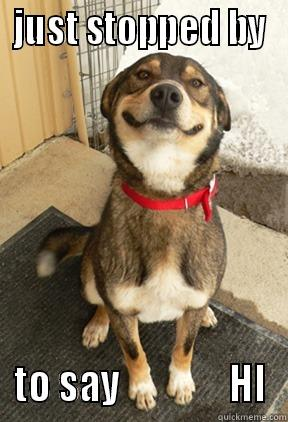
Si quieres causar impresión y obtener la más auténtica de las respuestas: ve allí. Hacerlo o morir, no hay intento.
7. Adoptar un enfoque individual
La clave para triunfar en los seguimientos o en cualquier táctica de ventas/marketing que implique escala y automatización es hacer todo lo posible para que su cliente potencial sienta que está implicado personalmente en la resolución de sus problemas.
Esto empieza con el primer contacto. No se conforme con acertar sólo con el nombre de pila, asegúrese de que su valor y su mensaje se adaptan a las personas a las que envía correos electrónicos. La función, el sector, el tamaño de la empresa y la geografía son variables que puede tener en cuenta a la hora de elaborar su mensaje. Si quieres ir un paso más allá, utiliza una herramienta como CrystalKnows para averiguar los tipos de personalidad de tus clientes potenciales y crear distintos tipos de texto para que tu mensaje llegue de la mejor manera posible.
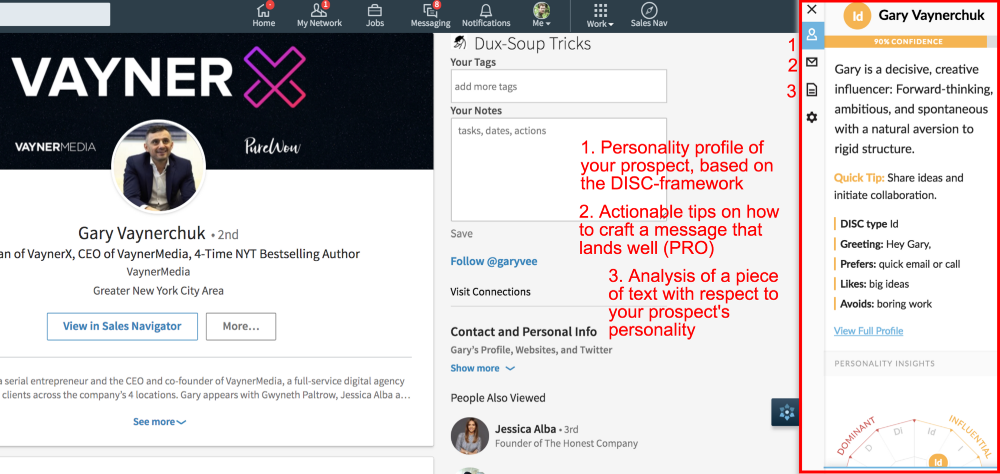
Puede utilizar los datos de Crystal para crear una variedad de correos electrónicos en frío alineados con la personalidad y/o utilizarlos en sus seguimientos tan pronto como un cliente potencial haya entrado en su canal de ventas. Si quieres saber cómo automatizar la obtención de datos de personalidad de los perfiles de LinkedIn con Crystal, ponte en contacto conmigo en Messenger.
Desde el momento en que te pones en modo de seguimiento, todo es cuestión de contexto. Para hacerlo bien se necesita toda la empatía y diligencia que puedas poner sobre la mesa.
Ya sea dos o siete veces, todos los días o todas las semanas, por correo electrónico o por distintos medios, todo depende de la situación en la que se encuentre el cliente potencial y de la relación y las interacciones que haya tenido con él. Todo depende del contexto.
No haces el mismo seguimiento con un CEO de una empresa de Fortune 500 que con un vendedor millennial de una startup de SaaS. El primero recibe miles de correos electrónicos cada día, el segundo probablemente responderá en diez minutos y luego te enviará una solicitud de conexión en LinkedIn.
8. Que sea breve, dulce, hábil, sucinto y específico.
No pierda el tiempo. Ni el suyo ni el de sus clientes potenciales.
Sabemos que estás enamorado de tu producto, pero describir por qué en tres párrafos interminables no va a hacer que tu cliente potencial sienta lo mismo. Puede que ni siquiera acaben leyéndolo. Cuando abro un correo electrónico y veo un trozo de texto, mi reflejo es tirarlo a la basura al instante. No puedo evitarlo, simplemente ocurre.
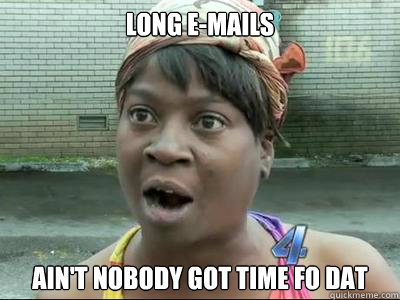
No puedes forzar ni controlar los sentimientos y convicciones de la gente. Perderse abiertamente en la presentación de un producto demuestra falta de empatía y alejará a tu cliente potencial en lugar de atraerlo. Ve al grano, aborda el dolor o el problema con el que están luchando y muestra cómo puedes resolverlo de una forma que despierte su curiosidad.
Esta pequeña interacción no trata de ti, sino de ellos y de cómo puedes ayudarles. Dedica tus palabras a una historia que tenga a tu destinatario como héroe y hazla lo suficientemente convincente como para que quiera saber qué viene después: haz que haga clic en ese CTA que le lleva a tu sitio web o a programar una llamada contigo.
9. Ayude a su cliente potencial a avanzar con llamadas a la acción
Los CTA son cruciales para garantizar un flujo constante de ida y vuelta. Debe tener un objetivo con cada correo electrónico de seguimiento que envíe y facilitar a su cliente potencial la consecución de dicho objetivo. No les corresponde a ellos averiguar qué viene después.

Incentívelos a iniciar una prueba, ofrézcales la descarga de su último libro electrónico, envíeles un enlace a su calendario o invítelos a su grupo de Facebook. Debes tener una idea clara de lo que quieres conseguir en cada fase del embudo de ventas y disponer de CTA específicas para inducir a tu cliente potencial a avanzar en ese embudo.
10. Añade una pizca de gracia
Pocas cosas en este mundo son tan contagiosas y conectan tanto como el buen humor.
Si alguna vez te han hecho un seguimiento, sabrás el escaso impacto que tiene el millonésimo correo electrónico de "sólo para comprobar". Pero, ¿y si la persona que está al otro lado añade a Bob Esponja para romper el aburrimiento?

O esta jirafa impaciente.

El mejor ejemplo de seguimiento por correo electrónico que he encontrado es el de los patitos bebés:
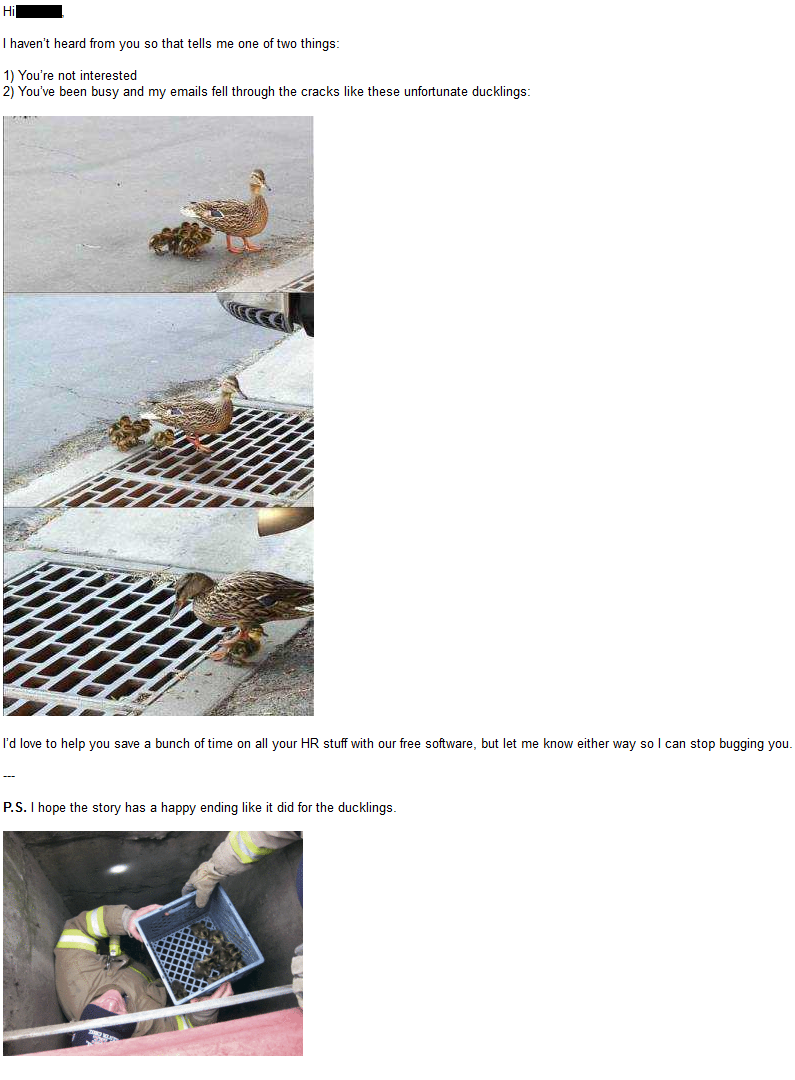
Hay montones de cosas que puedes hacer con GIFs, memes y simplemente con el viejo texto. Solo tienes que ser creativo y ver qué se pega.
Hacer reír es la forma más rápida de conectar con alguien, y te distinguirá de todos los correos electrónicos del tipo "sólo quería asegurarme de que sigues interesado en esto".
11. Pon tu sonrisa virtual más bonita en todo momento
Para la mayoría de las personas, la bandeja de entrada de su correo electrónico es un flujo interminable de frustración. Desbordada de correos sin leer, es una lista interminable de tareas pendientes.
No alimentes su malestar llamándoles la atención por no responderte. Cosas como "ya te he enviado tres correos electrónicos" o "dime que no estás interesado" sólo pueden ser contraproducentes. Es probable que tu cliente potencial ya se sienta culpable por no haberte respondido, así que hacerle sentir aún peor no va a cambiar la situación.
Cambia las cosas y afronta esta sensación de ansiedad como una oportunidad. Sé el hombre más grande y actúa con indiferencia ante el hecho de haber sido "ignorado" antes. Sigue transmitiendo una vibración de positividad y disponibilidad. Tus clientes potenciales desarrollarán sentimientos positivos hacia ti si consigues que se sientan cómodos cuando antes se sentían ansiosos.
Trate cada interacción como una nueva oportunidad de establecer una relación siendo persistentemente positivo.

Recapitulemos
Tanto si lo hace con clientes potenciales en frío como a lo largo de todo el proceso de ventas, el seguimiento le permitirá conseguir más ventas.
- Hacerlo de verdad es lo más importante. No tomes el silencio como un rechazo. El juego sólo puede acabar con un "sí" o un "no". Todo lo demás es rendirse.
- Para hacer más, automatiza todo lo que no necesite tu toque humano y utiliza una herramienta de CRM eficaz que te permita estar al tanto de todo. Todos y cada uno de los clientes potenciales merecen tu máxima paciencia, empatía y disponibilidad, y no puedes dárselas si te dedicas a realizar tareas administrativas sin sentido todo el tiempo.
- Mantente alerta, pero sabe cuándo parar. Tres veces silencio no equivale necesariamente a rechazo, pero cinco veces muy probablemente sí. No se trata de que no molestes a tus clientes potenciales, sino de que dediques tu tiempo a los más cualificados.
- Disminuya la frecuencia de sus correos electrónicos a medida que pase el tiempo. Si su cliente potencial no ha respondido a los tres primeros correos de seguimiento en una semana, es probable que no esté en situación de conectar con usted en ese momento. Si le envías un cuarto correo poco después, le molestarás más que cambiar las cosas.
- Pero juega a largo plazo. Como dice el refrán: tu valor neto es tu red. Aunque tu valor no sea inmediatamente relevante para un cliente potencial, nunca se sabe cómo podéis ayudaros mutuamente en el futuro. Las relaciones significativas te harán avanzar, en los negocios y en la vida.
- No confíes en tu cerebro para recordar cuándo hacer un seguimiento, te fallará. Establece recordatorios de seguimiento y automatiza los correos rutinarios.
- Utiliza tu cerebro para llegar al cliente potencial. Averigüe qué les motiva, elabore un mensaje que se adapte a su caso particular y utilice el humor para destacar entre el ruido. Guíalos a través de su propia narrativa y hacia objetivos intermitentes.
- Por último, no te limites al correo electrónico para entablar relación con algunos. Hay mucho más.
La persona que está al otro lado es un ser humano como tú. Si eres capaz de ponerte en su lugar y aportar un valor relevante, no debes dejar que nada te desanime a seguir adelante. Nunca te sientas mal por dedicarte a ayudar a la gente.
Quieres ver más formas de utilizar la automatización del correo electrónico? Eche un vistazo a estos vídeos de casos prácticos de flujos de trabajo de correo electrónico realizados por nuestros clientes.
- Los 20 mejores libros de ventas que probablemente esté leyendo Elon Musk - 14 de febrero de 2023
- 6 formas infalibles de conseguir para tu startup sus primeros 100 clientes - 6 de diciembre de 2022
- Cómo construir un embudo de ventas que venda - 2 de septiembre de 2021
